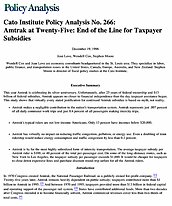- Amtrak makes a negligible contribution to the nation’s transportation system. Amtrak represents just .007 percent of all daily commuter work trips and just 0.4 percent of all passengers making intercity trips.
- Amtrak’s typical riders are not low-income Americans. Only 13 percent have incomes below $20,000.
- Amtrak has virtually no impact on reducing traffic congestion, pollution, or energy use. Even a doubling of train ridership would reduce energy consumption and traffic congestion by less than 0.1 percent.
- Amtrak is by far the most highly subsidized form of intercity transportation. The average taxpayer subsidy per Amtrak rider is $100, or 40 percent of the total per-passenger cost. On some of the long-distance routes, such as New York to Los Angeles, the taxpayer subsidy per passenger exceeds $1,000. It would be cheaper for taxpayers to close down expensive lines and purchase discount round-trip airfare for all the Amtrak riders.
Amtrak at Twenty-Five: End of the Line for Taxpayer Subsidies
This year Amtrak is celebrating its silver anniversary. Unfortunately, after 25 years of federal ownership and $13 billion of federal subsidies, Amtrak appears no closer to financial independence than the day taxpayer assistance began. This study shows that virtually every stated justification for continued Amtrak subsidies is based on myth, not reality.
About the Authors
Wendell Cox and Jean Love are economic consultants headquartered in the St. Louis area. They specialize in labor, public finance, and transportation issues in the United States, Canada, Europe, Australia, and New Zealand. Stephen Moore is director of fiscal policy studies at the Cato Institute.

This work is licensed under a Creative Commons Attribution-NonCommercial-ShareAlike 4.0 International License.
